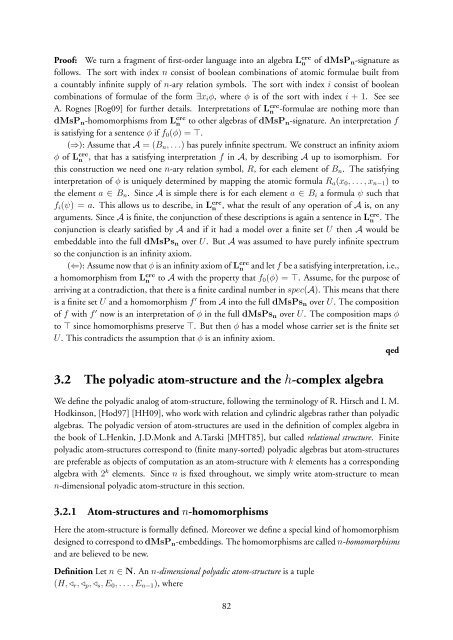On the methods of mechanical non-theorems (latest version)
On the methods of mechanical non-theorems (latest version)
On the methods of mechanical non-theorems (latest version)
You also want an ePaper? Increase the reach of your titles
YUMPU automatically turns print PDFs into web optimized ePapers that Google loves.
Pro<strong>of</strong>: We turn a fragment <strong>of</strong> first-order language into an algebra L crc<br />
n <strong>of</strong> dMsP n -signature as<br />
follows. The sort with index n consist <strong>of</strong> boolean combinations <strong>of</strong> atomic formulae built from<br />
a countably infinite supply <strong>of</strong> n-ary relation symbols. The sort with index i consist <strong>of</strong> boolean<br />
combinations <strong>of</strong> formulae <strong>of</strong> <strong>the</strong> form ∃x i φ, where φ is <strong>of</strong> <strong>the</strong> sort with index i + 1. See see<br />
A. Rognes [Rog09] for fur<strong>the</strong>r details. Interpretations <strong>of</strong> L crc<br />
n -formulae are nothing more than<br />
dMsP n -homomorphisms from L crc<br />
n to o<strong>the</strong>r algebras <strong>of</strong> dMsP n -signature. An interpretation f<br />
is satisfying for a sentence φ if f 0 (φ) = ⊤.<br />
(⇒): Assume that A = (B n , . . .) has purely infinite spectrum. We construct an infinity axiom<br />
φ <strong>of</strong> L crc<br />
n , that has a satisfying interpretation f in A, by describing A up to isomorphism. For<br />
this construction we need one n-ary relation symbol, R, for each element <strong>of</strong> B n . The satisfying<br />
interpretation <strong>of</strong> φ is uniquely determined by mapping <strong>the</strong> atomic formula R a (x 0 , . . . , x n−1 ) to<br />
<strong>the</strong> element a ∈ B n . Since A is simple <strong>the</strong>re is for each element a ∈ B i a formula ψ such that<br />
f i (ψ) = a. This allows us to describe, in L crc<br />
n , what <strong>the</strong> result <strong>of</strong> any operation <strong>of</strong> A is, on any<br />
arguments. Since A is finite, <strong>the</strong> conjunction <strong>of</strong> <strong>the</strong>se descriptions is again a sentence in L crc<br />
n . The<br />
conjunction is clearly satisfied by A and if it had a model over a finite set U <strong>the</strong>n A would be<br />
embeddable into <strong>the</strong> full dMsPs n over U. But A was assumed to have purely infinite spectrum<br />
so <strong>the</strong> conjunction is an infinity axiom.<br />
(⇐): Assume now that φ is an infinity axiom <strong>of</strong> L crc<br />
n and let f be a satisfying interpretation, i.e.,<br />
a homomorphism from L crc<br />
n to A with <strong>the</strong> property that f 0 (φ) = ⊤. Assume, for <strong>the</strong> purpose <strong>of</strong><br />
arriving at a contradiction, that <strong>the</strong>re is a finite cardinal number in spec(A). This means that <strong>the</strong>re<br />
is a finite set U and a homomorphism f ′ from A into <strong>the</strong> full dMsPs n over U. The composition<br />
<strong>of</strong> f with f ′ now is an interpretation <strong>of</strong> φ in <strong>the</strong> full dMsPs n over U. The composition maps φ<br />
to ⊤ since homomorphisms preserve ⊤. But <strong>the</strong>n φ has a model whose carrier set is <strong>the</strong> finite set<br />
U. This contradicts <strong>the</strong> assumption that φ is an infinity axiom.<br />
qed<br />
3.2 The polyadic atom-structure and <strong>the</strong> h-complex algebra<br />
We define <strong>the</strong> polyadic analog <strong>of</strong> atom-structure, following <strong>the</strong> terminology <strong>of</strong> R. Hirsch and I. M.<br />
Hodkinson, [Hod97] [HH09], who work with relation and cylindric algebras ra<strong>the</strong>r than polyadic<br />
algebras. The polyadic <strong>version</strong> <strong>of</strong> atom-structures are used in <strong>the</strong> definition <strong>of</strong> complex algebra in<br />
<strong>the</strong> book <strong>of</strong> L.Henkin, J.D.Monk and A.Tarski [MHT85], but called relational structure. Finite<br />
polyadic atom-structures correspond to (finite many-sorted) polyadic algebras but atom-structures<br />
are preferable as objects <strong>of</strong> computation as an atom-structure with k elements has a corresponding<br />
algebra with 2 k elements. Since n is fixed throughout, we simply write atom-structure to mean<br />
n-dimensional polyadic atom-structure in this section.<br />
3.2.1 Atom-structures and n-homomorphisms<br />
Here <strong>the</strong> atom-structure is formally defined. Moreover we define a special kind <strong>of</strong> homomorphism<br />
designed to correspond to dMsP n -embeddings. The homomorphisms are called n-homomorphisms<br />
and are believed to be new.<br />
Definition Let n ∈ N. An n-dimensional polyadic atom-structure is a tuple<br />
(H, ⊳ r , ⊳ p , ⊳ s , E 0 , . . . , E n−1 ), where<br />
82
















